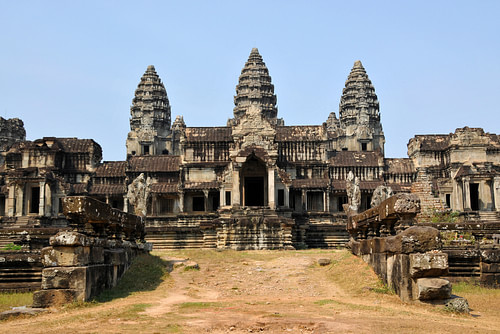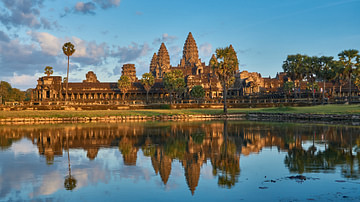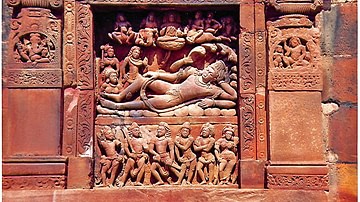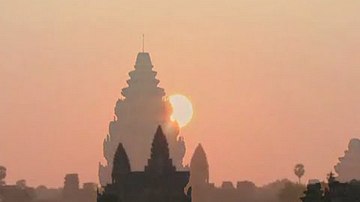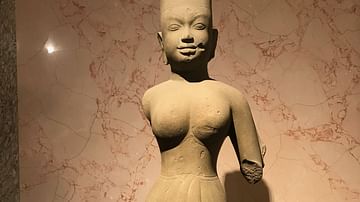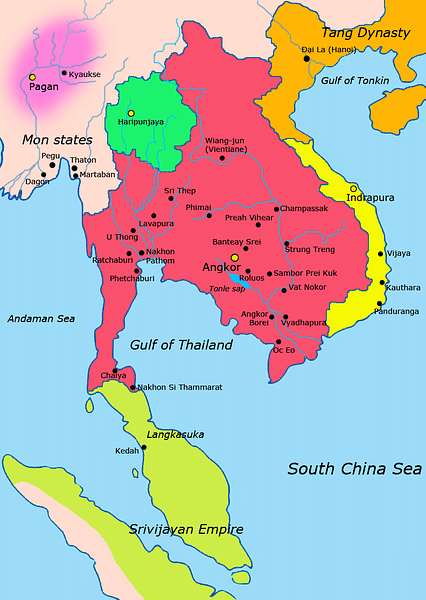
The Khmer Empire was a powerful state in South East Asia, formed by people of the same name, lasting from 802 CE to 1431 CE. At its peak, the empire covered much of what today is Cambodia, Thailand, Laos, and southern Vietnam.
By the 7th century CE, Khmer people inhabited territories along the Mekong river -the world's seventh longest river - from the delta to roughly the modern Cambodia-Laos border, plus the region between that river and the great Tonle Sap lake to the west and the area running along the Tonle Sap river (which runs from the lake to the sea, joining the Mekong in the delta). There were several kingdoms at constant war against each other, with art and culture heavily influenced by India due to long established sea trade routes with that subcontinent.
Hinduism mostly, but Buddhism as well, were important religions in the region, mixed with animist and traditional cults. Important cities from that time include Angkor Borei, Sambor Prei Kuk, Banteay Prei Nokor and Wat Phu. A man called Jayavarman II, who is said to have come from a place named Java - which may or may not be the island we call Java in Southeast Asia, led a series of successful military campaigns, subjugating most of these petty kingdoms, that resulted in the founding of a large territorial state. In 802 CE he took the title chakravartin, “universal ruler”, and that date is used to signal the start of the empire.
Using the city of Angkor as capital, for the next centuries the Khmer empire expanded its territorial base, mostly to the north (entering the Khorat plateau) and the west, to the Chao Phraya basin and beyond. To the east outcomes were different: several times the Khmer fought wars against two neighboring peoples with powerful kingdoms, the Cham (in today's central Vietnam) and the Vietnamese (in today's northern Vietnam). Despite some victories, as in 1145 CE, when Cham's capital Vijaya was taken, the empire was never able to annex those lands. Conversely, Chams and Vietnamese enjoyed some victories of their own, the most spectacular of which was Cham's humiliating revenge, looting Angkor (1177 CE) and pushing the empire to the edge of destruction.
Throughout the empire's history, Khmer's court was repeatedly concerned with putting down rebellions initiated by ambitious nobles trying to achieve independence, or fighting conspiracies against the king. This was particularly true each time a king died, as successions were usually contested.
The Khmer were great builders, filling the landscape with monumental temples, huge reservoirs (called baray) and canals, and laying an extensive road network with all sorts of bridges -the main highways are 800 km long. The most stunning temple, Angkor Wat, is a microcosm of the Hindu universe and defies imagination as the world's largest religious complex - covering 200 hectares; nowadays it is crowded with tourists amazed with ruins that until recently were covered by the jungle. Its construction took some 30 years and was started by one of the greatest kings, Suryavarman II, around 1122 CE.
The empire's greatest king was Jayavarman VII (r. 1181 CE - 1215 CE). He expelled the Chams who took Angkor, restoring the realm from anarchy, and then invaded Champa (Cham's kingdom). The scale of his construction programme was unprecedented: he built temples, monuments, highways, a hundred hospitals, and the spectacular Angkor Thom complex - a city within a city in Angkor. Jayavarman also expanded the empire's territorial control to its zenith.
Angkor's original name was Yashodharapura (“Glory-bearing city”), and at its apogee it was the biggest city in the world, covering an area of a thousand square kilometres, close to that of modern Los Angeles in the USA. Its population is much harder to estimate, but a figure of aproximately one million is acceptable.
The Khmer were festive people, with many celebrations all the year round. Wrestling, horse races, cock fights, fireworks, music and dances were an integral part of their culture. Most of the realm's commerce was apparently in the hands of women.The king and the elite were transported on palanquins, and used umbrellas to cover from the sun. There were several religious beliefs present, with Hinduism being favoured (yet not exclusively) by the the kings at first, and Buddhism later. The state was divided into approximately 23 provinces, with a sophisticated administration and extensive personnel going down even to the village level. Censuses were carried out periodically. Although key to the empire's prosperity, the high officers of this bureaucracy were also part of the plots that plagued the court's history.
The empire's decline and final collapse is deeply connected with the great Thai migration of the 12th-14th centuries CE. They inhabitated an area to the north of the empire, roughly where China ends and Southeast Asia begins; the Yunnan. It is a mountainous, harsh land, where a Thai kingdom called Nanchao existed. For unknown reasons, Thai populations started migrating south, in small groups at first. Thais first appear in records as as hired mercenaries for the empire, and their numbers rose as they began to establish themselves as settlers in marginal areas. The migration intensified when Mongol campaigns shook China, and when the Mongols took Yunnan in 1253 CE, further pressure for Thai migration ensued. Eventually the Thai created their own small kingdoms, the most important of them in the western side of the empire. As these kingdoms grew in power, they started to attack and annex imperial territories. The empire's economy by this time may also have been deteriorated by increased silting of the massive water works that the Khmer core area depended on. The Thai kingdom of Ayutthaya took Angkor in 1431 CE, which constitutes the end of the Khmer empire.
